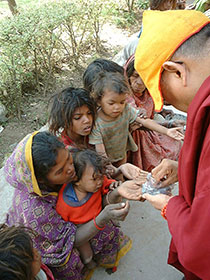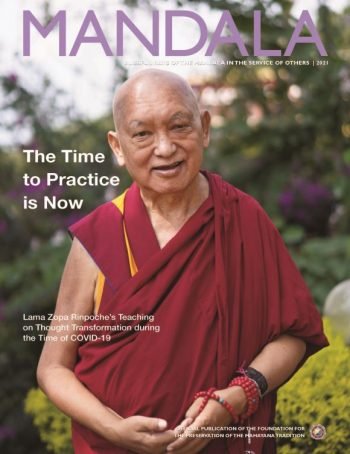- Home
- FPMT Homepage
Foundation for the Preservation of the Mahayana Tradition
The FPMT is an organization devoted to preserving and spreading Mahayana Buddhism worldwide by creating opportunities to listen, reflect, meditate, practice and actualize the unmistaken teachings of the Buddha and based on that experience spreading the Dharma to sentient beings. We provide integrated education through which people’s minds and hearts can be transformed into their highest potential for the benefit of others, inspired by an attitude of universal responsibility and service. We are committed to creating harmonious environments and helping all beings develop their full potential of infinite wisdom and compassion. Our organization is based on the Buddhist tradition of Lama Tsongkhapa of Tibet as taught to us by our founders Lama Thubten Yeshe and Lama Thubten Zopa Rinpoche.
- Willkommen
Die Stiftung zur Erhaltung der Mahayana Tradition (FPMT) ist eine Organisation, die sich weltweit für die Erhaltung und Verbreitung des Mahayana-Buddhismus einsetzt, indem sie Möglichkeiten schafft, den makellosen Lehren des Buddha zuzuhören, über sie zur reflektieren und zu meditieren und auf der Grundlage dieser Erfahrung das Dharma unter den Lebewesen zu verbreiten.
Wir bieten integrierte Schulungswege an, durch denen der Geist und das Herz der Menschen in ihr höchstes Potential verwandelt werden zum Wohl der anderen – inspiriert durch eine Haltung der universellen Verantwortung und dem Wunsch zu dienen. Wir haben uns verpflichtet, harmonische Umgebungen zu schaffen und allen Wesen zu helfen, ihr volles Potenzial unendlicher Weisheit und grenzenlosen Mitgefühls zu verwirklichen.
Unsere Organisation basiert auf der buddhistischen Tradition von Lama Tsongkhapa von Tibet, so wie sie uns von unseren Gründern Lama Thubten Yeshe und Lama Thubten Zopa Rinpoche gelehrt wird.
- Bienvenidos
La Fundación para la preservación de la tradición Mahayana (FPMT) es una organización que se dedica a preservar y difundir el budismo Mahayana en todo el mundo, creando oportunidades para escuchar, reflexionar, meditar, practicar y actualizar las enseñanzas inconfundibles de Buda y en base a esa experiencia difundir el Dharma a los seres.
Proporcionamos una educación integrada a través de la cual las mentes y los corazones de las personas se pueden transformar en su mayor potencial para el beneficio de los demás, inspirados por una actitud de responsabilidad y servicio universales. Estamos comprometidos a crear ambientes armoniosos y ayudar a todos los seres a desarrollar todo su potencial de infinita sabiduría y compasión.
Nuestra organización se basa en la tradición budista de Lama Tsongkhapa del Tíbet como nos lo enseñaron nuestros fundadores Lama Thubten Yeshe y Lama Zopa Rinpoche.
A continuación puede ver una lista de los centros y sus páginas web en su lengua preferida.
- Bienvenue
L’organisation de la FPMT a pour vocation la préservation et la diffusion du bouddhisme du mahayana dans le monde entier. Elle offre l’opportunité d’écouter, de réfléchir, de méditer, de pratiquer et de réaliser les enseignements excellents du Bouddha, pour ensuite transmettre le Dharma à tous les êtres. Nous proposons une formation intégrée grâce à laquelle le cœur et l’esprit de chacun peuvent accomplir leur potentiel le plus élevé pour le bien d’autrui, inspirés par le sens du service et une responsabilité universelle. Nous nous engageons à créer un environnement harmonieux et à aider tous les êtres à épanouir leur potentiel illimité de compassion et de sagesse. Notre organisation s’appuie sur la tradition guéloukpa de Lama Tsongkhapa du Tibet, telle qu’elle a été enseignée par nos fondateurs Lama Thoubtèn Yéshé et Lama Zopa Rinpoché.
Visitez le site de notre Editions Mahayana pour les traductions, conseils et nouvelles du Bureau international en français.
Voici une liste de centres et de leurs sites dans votre langue préférée
- Benvenuto
L’FPMT è un organizzazione il cui scopo è preservare e diffondere il Buddhismo Mahayana nel mondo, creando occasioni di ascolto, riflessione, meditazione e pratica dei perfetti insegnamenti del Buddha, al fine di attualizzare e diffondere il Dharma fra tutti gli esseri senzienti.
Offriamo un’educazione integrata, che può trasformare la mente e i cuori delle persone nel loro massimo potenziale, per il beneficio di tutti gli esseri, ispirati da un’attitudine di responsabilità universale e di servizio.
Il nostro obiettivo è quello di creare contesti armoniosi e aiutare tutti gli esseri a sviluppare in modo completo le proprie potenzialità di infinita saggezza e compassione.
La nostra organizzazione si basa sulla tradizione buddhista di Lama Tsongkhapa del Tibet, così come ci è stata insegnata dai nostri fondatori Lama Thubten Yeshe e Lama Zopa Rinpoche.
Di seguito potete trovare un elenco dei centri e dei loro siti nella lingua da voi prescelta.
- 欢迎 / 歡迎
简体中文
“护持大乘法脉基金会”( 英文简称:FPMT。全名:Foundation for the Preservation of the Mahayana Tradition) 是一个致力于护持和弘扬大乘佛法的国际佛教组织。我们提供听闻,思维,禅修,修行和实证佛陀无误教法的机会,以便让一切众生都能够享受佛法的指引和滋润。
我们全力创造和谐融洽的环境, 为人们提供解行并重的完整佛法教育,以便启发内在的环宇悲心及责任心,并开发内心所蕴藏的巨大潜能 — 无限的智慧与悲心 — 以便利益和服务一切有情。
FPMT的创办人是图腾耶喜喇嘛和喇嘛梭巴仁波切。我们所修习的是由两位上师所教导的,西藏喀巴大师的佛法传承。
繁體中文
護持大乘法脈基金會”( 英文簡稱:FPMT。全名:Found
ation for the Preservation of the Mahayana Tradition ) 是一個致力於護持和弘揚大乘佛法的國際佛教組織。我們提供聽聞, 思維,禪修,修行和實證佛陀無誤教法的機會,以便讓一切眾生都能 夠享受佛法的指引和滋潤。 我們全力創造和諧融洽的環境,
為人們提供解行並重的完整佛法教育,以便啟發內在的環宇悲心及責 任心,並開發內心所蘊藏的巨大潛能 — 無限的智慧與悲心 – – 以便利益和服務一切有情。 FPMT的創辦人是圖騰耶喜喇嘛和喇嘛梭巴仁波切。
我們所修習的是由兩位上師所教導的,西藏喀巴大師的佛法傳承。 察看道场信息:
- FPMT Homepage
- News/Media
-
- Study & Practice
-
-
- About FPMT Education Services
- Latest News
- Programs
- New to Buddhism?
- Buddhist Mind Science: Activating Your Potential
- Heart Advice for Death and Dying
- Discovering Buddhism
- Living in the Path
- Exploring Buddhism
- FPMT Basic Program
- FPMT Masters Program
- FPMT In-Depth Meditation Training
- Maitripa College
- Lotsawa Rinchen Zangpo Translator Program
- Universal Education for Compassion & Wisdom
- Online Learning Center
-
- Prayers & Practice Materials
- Overview of Prayers & Practices
- Full Catalogue of Prayers & Practice Materials
- Explore Popular Topics
- Benefiting Animals
- Chenrezig Resources
- Death & Dying Resources
- Lama Chopa (Guru Puja)
- Lama Zopa Rinpoche: Compendium of Precious Instructions
- Lama Zopa Rinpoche: Life Practice Advice
- Lama Zopa Rinpoche Practice Series
- Lamrim Resources
- Mantras
- Prayer Book Updates
- Purification Practices
- Sutras
- Thought Transformation (Lojong)
- Audio Materials
- Dharma Dates - Tibetan Calendar
- Translation Services
- Publishing Services
- Ways to Offer Support
- Prayers & Practice Materials
-
- Teachings and Advice
- Find Teachings and Advice
- Lama Zopa Rinpoche Advice Page
- Lama Zopa Rinpoche: Compendium of Precious Instructions
- Lama Zopa Rinpoche Video Teachings
- ༧སྐྱབས་རྗེ་བཟོད་པ་རིན་པོ་ཆེ་མཆོག་ནས་སྩལ་བའི་བཀའ་སློབ་བརྙན་འཕྲིན།
- Podcasts
- Lama Yeshe Wisdom Archive
- Buddhism FAQ
- Dharma for Young People
- Resources on Holy Objects
- Teachings and Advice
-
-
*If a menu item has a submenu clicking once will expand the menu clicking twice will open the page.
-
-
- Centers
-
- Teachers
-
- Projects
-
-
-
-
*If a menu item has a submenu clicking once will expand the menu clicking twice will open the page.
-
-
- FPMT
-
-
-
-
-
[It will be best] to include meditation practice and retreat requirements with the study of the subjects, so as to ensure students are given help integrating the three aspects of hearing, contemplation, and meditation.
Lama Zopa Rinpoche
-
-
-
- Shop
-
-
-
The Foundation Store is FPMT’s online shop and features a vast selection of Buddhist study and practice materials written or recommended by our lineage gurus. These items include homestudy programs, prayers and practices in PDF or eBook format, materials for children, and other resources to support practitioners.
Items displayed in the shop are made available for Dharma practice and educational purposes, and never for the purpose of profiting from their sale. Please read FPMT Foundation Store Policy Regarding Dharma Items for more information.
-
-
FPMT News Around the World
21
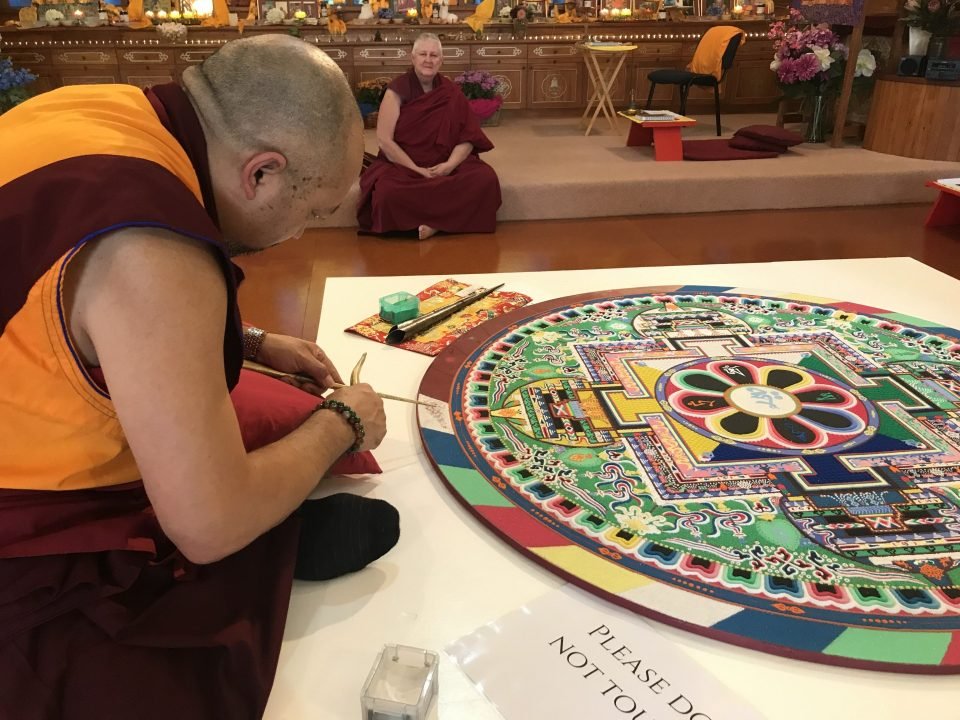
Sand Mandala Festival at Mahamudra Centre for Universal Unity, Colville, New Zealand, March 2021. Photo by Jennifer Coyne.
Mahamudra Centre for Universal Unity, the FPMT center in Colville, New Zealand, welcomed school children and other community members to their center for a big ten-day celebration. Jennifer Coyne, spiritual program coordinator, shares the story.
We celebrated our forty-year anniversary in 2021 with a Chenrezig Sand Mandala Festival! We invited two Tibetan monks who live in New Zealand to come to our center to create the sand mandala. The making of a sand mandala is a practice that uses tiny grains of colored sand to represent the celestial abode of a particular Buddha. There are many different mandalas. The monks created the mandala of Chenrezig, the Buddha of Compassion. It was chosen to radiate the enlightened, healing, compassionate energy of Chenrezig into this world.
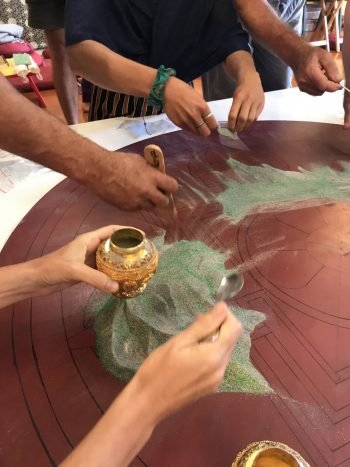
Dissolving the sand mandala at Mahamudra Centre for Universal Unity, Colville, New Zealand, March 2021. Photo by Jennifer Coyne.
Our community came together for an opening ceremony to request permission from the local protectors and deities in the environment. The monks then began constructing the mandala by using a metal funnel, tapping it with a deer antler horn to allow a stream of sand to trickle out. Each detail has a profound meaning and very specific pattern, which the monks had studied and memorized at a tantric college in South India. The mandala took ten days to create, and the process was incredible to watch.
Merely seeing this mandala plants a seed of compassion in the mindstream, and so we were delighted to welcome many visitors. Many locals and tourists who had never visited us before dropped in for our Sand Mandala Festival. We estimate approximately one hundred people viewed the mandala or joined the prayers and guided meditations.
The two monks led the morning and evening prayers, and our resident nuns Ven. Nangsel and Ven. Khadro led the guided meditations. One of the monks brought some extra tools so that visitors could try to create their own mandala. We quickly realized how much skill is required to construct a sand mandala.
A highlight for us was the school tour. Elizabeth, a teacher at Colville School, brought her class of students to view the mandala and try their hand at making their own mandalas. The students were around six years old. Elizabeth has a long-time connection with our center. She often joins us for our community meditations and has volunteered her time here in the past.
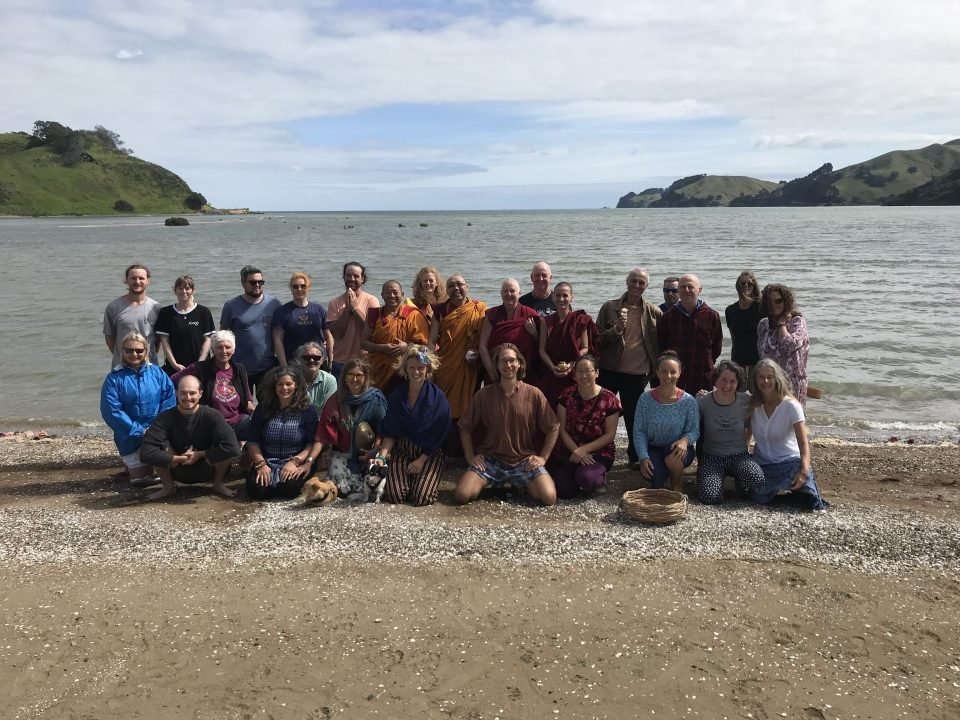
Mahamudra Centre for Universal Unity community, Colville, New Zealand, March 2021. Photo by Jennifer Coyne.
We had a closing ceremony to dedicate the merit after the monks had finished the mandala. Geshe Jamyang, one of the monks who created the sand mandala, reminded us of the importance of dedication. It allows the merit or positive energy to continue to flow and expand even long after the mandala has been dissolved. The mandala was so beautiful; it seemed a shame to dissolve it. Geshe Jamyang reminded us that just as our bodies are born, slowly decay, and then die, and just as a seed slowly blooms into a flower, everything material is subject to impermanence.
We poured the blessed sand into the ocean so we could offer the blessings to all sentient beings. Since all of the planet’s water bodies are interconnected, offering blessed sand to a single water body means that the blessings will radiate through the whole planet. The blessed sand will nourish and protect the well-being of the environment and all the beings who dwell in it. Gathered together at the water’s edge, our community said our final prayers while visualizing the blessings going out into the world. We especially visualized those blessings going to those who need it most.
Watch the seven-minute video “Chenrezig Sand Mandala at Mahamudra Centre” to see the process from beginning to end:
https://youtu.be/lht2wcqI2LI
We were honored to welcome Geshe Jamyang and Ven. Karma to our center to create the mandala. Geshe Jamyang is the resident teacher at Tashi Choepel Ling in Tauranga, and Ven. Karma resides at Jam Tse Dhargyey Ling in Whangarei. They grew up together in Tibet, studied together at Sera Je Monastic University, and have both been living in New Zealand for more than ten years. They often come together to create sand mandalas at locations throughout New Zealand, usually in art galleries or public spaces. They were excited to create a sand mandala in a gompa, and we were excited to welcome them back to our center!
To learn more about Mahamudra Centre for Universal Responsibility, visit their website:
https://mahamudra.org.nz/
FPMT.org and Mandala Publications brings you news of Lama Zopa Rinpoche and of activities, teachings, and events from over 160 FPMT centers, projects, and services around the globe. If you like what you read, consider becoming a Friend of FPMT, which supports our work.
- Tagged: jennifer coyne, mahamudra centre, sand mandala, sand mandalas, sera je monastery, sera je monastic university
16
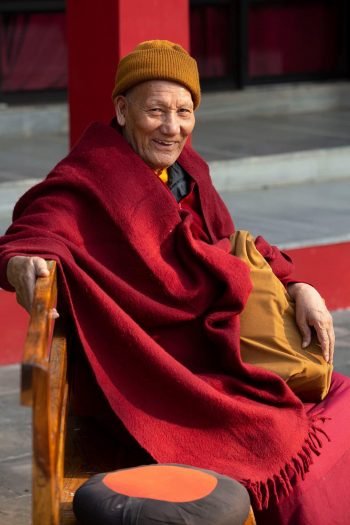
Ladakhi Lama at Root Institute for Wisdom Culture, Bodhgaya, Gaya District, Bihar, India. Photo by Paolo Regis (@paoloregisphotography).
We are saddened to share the news that Ven. Thupten Tsewang (also known as Ladakhi Lama and Baling Lama), born in Ladakh, India, passed away at the age of 92, at Kalpataru Buddha Vihar, Nagpur, Maharashtra, India, on April 25, 2021, of natural causes.
Ladakhi Lama had been an attendant to Indian Buddhist master Khunu Lama Tenzin Gyaltsen Rinpoche (1894–1977). In his later years he was a part-time resident at Root Institute for Wisdom Culture in Bodhgaya, Gaya District, Bihar, India.
Geshe Ngawang Rabga, the FPMT resident geshe at Root Institute from 2016–2020, wrote a kind remembrance of Gen-la, as Ladakhi Lama was sometimes called, to share with the international FPMT community:
“Gen-la was very respectable and close to me. His demise has saddened me deeply. He lived his life as a fully ordained monk and received Dharma teachings from many great masters like His Holiness the Dalai Lama and Kyabje Zopa Rinpoche. Therefore, he made his life a meaningful one. I truly appreciate the life he lived. I pray from my heart that he returns in his next life as a great teacher of the Buddhadharma in general, and especially of the teachings of Lama Tsongkhapa.”
In his younger days, before he ordained, Ladakhi Lama worked as a radio broadcaster at All India Radio in Ladakh. Ven. Tenzin Paldron, center director at Root Institute from 2015–2019, and Annie McGhee, who volunteered at the center, remembered him as an avid reader of The Times of India. “Lama loved to read the newspaper on a daily basis and was very well versed in political affairs in India and loved to discuss politics with the guests that visited,” Ven. Paldron said. Annie added, “He loved a good debate and engaged in many animated discussions over meals at the dining table.”
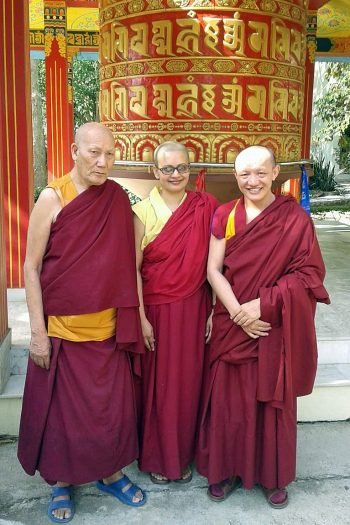
Ladakhi Lama, Ven. Tenzin Paldron, and Geshe Ngawang Rabga at Root Institute for Wisdom Culture, Bodhgaya, Gaya District, Bihar, India. Photo courtesy of Root Institute.
Ladakhi Lama met Khunu Lama in Varanasi in 1954, and Khunu Lama ordained him shortly after their meeting. After six years of being a devoted disciple, he became Khunu Lama’s attendant in 1960. Ven. Paldron said, “He often regaled many of us in the dining hall with stories of the times he spent serving high lamas like Khunu Lama and Denma Locho Rinpoche, and of the rich and varied experiences that he had living as an ordained monk in various temples.”
Annie recalled, “One story which really moved me was when Ladakhi Lama was making lunch—probably rice and dhal—and Khunu Lama told him, ‘Stop cooking now; we have to practice.’ So they had half-cooked rice for lunch! If only we had that dedication and commitment to study and practice the Dharma in the most beneficial way and not waste time on trivialities like food.”
Ladakhi Lama lived in various places, such as Mumbai and Nagpur, before going to Bodhgaya, which is where he met Lama Zopa Rinpoche. Rinpoche requested that Ladakhi Lama stay at Root Institute. “When I became director of Root Institute in June 2015, the first task given to me by Rinpoche was, ‘Take good care of Ladakhi Lama,’” Ven. Paldron said.
He became a much valued presence at Root Institute. “He was like a fatherly figure to us in many ways, often giving us teachings and advice, including making predictions such as who would get ordained,” Ven. Paldron said.
Vicki Taylor, another volunteer at the center, said, “Gen-la was a quiet and friendly presence for several years, bringing humor and cheer to our guests—especially in the dining hall. Despite his advanced age, Gen-la retained the fresh perspective and cheeky sweetness of a child, and I’m sure this gentle presence radiating Dharma contentment benefited many people.”
Indian monk Ven. Tashi Choedup first met Ladakhi Lama at Root Institute in 2017 and had many fond memories of him to share:
“Newly ordained myself, I hadn’t met many Indian ordained Sangha, Himalayan or otherwise; Lama was one of the first. His welcoming nature, warmth, love, and our ability to communicate in Hindi helped us establish a connection from our very first meeting. Lama was generous, sharing stories from his life experiences during our mealtimes. No matter how brief a guest’s visit to Root Institute was, all were touched by Lama’s infectious smile and kindness.
“Lama took me to my first ever Sangha dana ceremony and to many more such gatherings in Bodhgaya thereafter. I fondly remember making a trip to Patna Museum with Lama to pay respects to Buddha relics there.
“I also had the fortune of living in the room next to Lama’s and had the blessing of waking up to Lama’s prayers as early as 3 A.M. every morning. Although we only knew each other for a few years, Lama inspired me to practice Dharma more diligently and gave me the confidence to live an ordained life until the very end.
“Of Lama’s many qualities, one that was always visible was his giving nature. He was always giving away whatever money, food, or resources he had with him. He would never keep anything for himself—except maybe for the packets of Yippee instant noodles, his favorite.”
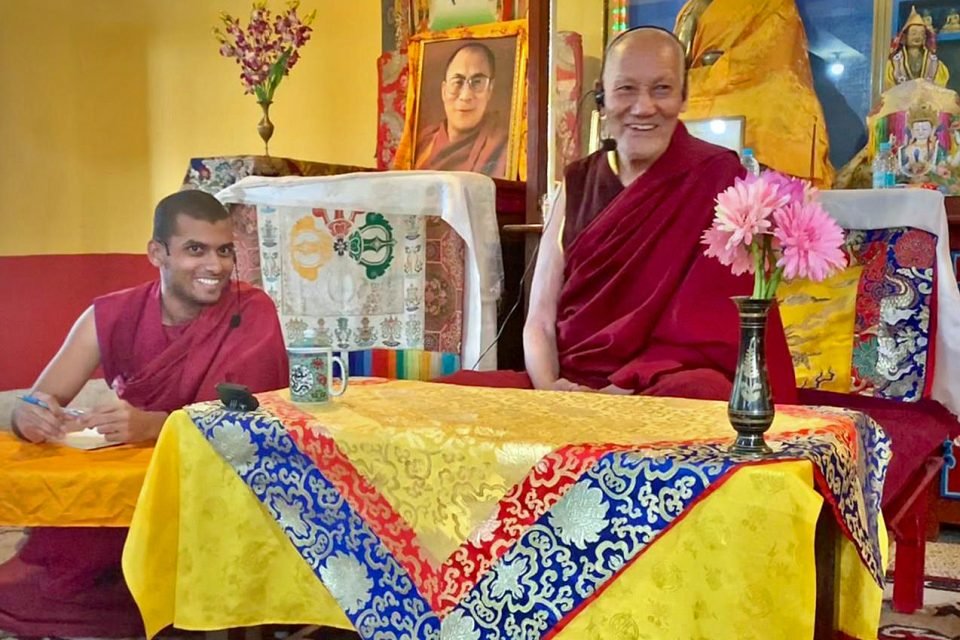
Ven. Tashi Choedup and Ladakhi Lama at Root Institute for Wisdom Culture, Bodhgaya, Gaya District, Bihar, India, November 2019. Photo by Ven. Thubten Munsel.
Inder Kant, who met Ladakhi Lama in 2016 in Bodhgaya, commented on his kindness and humor as well as his profound generosity, recalling a story about visiting a very sick 102-year-old lama at a Tibetan monastery in Bodhgaya with Ladakhi Lama. “We gave the lama some food we had brought for him,” Inder said. “Ladakhi Lama used to visit the elderly lama, looking after him. The lama’s room was messy so Ladakhi Lama and I cleaned the room and made his bed with a new bed sheet. It was overwhelming to see the kindness of Ladakhi Lama.”
Ven. Paldron recounted another quality of Ladakhi Lama: “He was not afraid to challenge someone’s authority, no matter what their position was, if Lama thought they were behaving unethically or inappropriately. He shared various stories of how he had confronted bullies—including some lamas in temples—to make sure that the vulnerable and needy were treated fairly and justly. Lama did not care about his reputation or what would happen to him. If something needed to be corrected, he spoke out against it very fiercely.”
Ladakhi Lama was also very knowledgeable about the history of Bodhgaya and the Mahabodhi Stupa, as well as the significance of many of the small and large stupas around the main temple. He also knew all the main pilgrimage sites.
“In early October 2016, I arrived at Root Institute to volunteer for the winter season,” Annie McGhee said. “I had longed to go to Vikramashila, the home monastery of Lama Atisha. This pilgrimage site is in northeastern Bihar, a region unsafe to travel to as a single woman. I had made many prayers to go and had mentioned this to two friends. One morning I was standing in the breakfast queue when Ladakhi Lama came up to me and said, ‘You want to go to Vikramashila? OK, I will take you.’ I was overjoyed but a little concerned for Lama because it would be a long journey with rough conditions.
“A few of us from Root Institute made the trip together, traveling for ten hours one way by Jeep. At the entrance we stopped to take it all in, as it was a large and important monastic university in its time. Lama remarked, ‘Here is what is left of stupas that would have held the 108 arhats who resided at Vikramashila.’ He was quiet and reflective at other places but led us in many practices and prayers at some of the holy sites.”

Ladakhi Lama and Lama Zopa Rinpoche at the Mahabodhi Stupa, Bodhgaya, Gaya District, Bihar, India, 2015. Photo by Andy Melnic.
Sharing her favorite memory of Ladakhi Lama, Vicki Taylor said, “Lama Zopa Rinpoche had requested from Gen-la the oral transmission of Gampopa’s classic lamrim text The Jewel Ornament of Liberation, which he himself had received from Khunu Lama. The transmission took more than one session, and a few of us were gathered in the Root Institute’s small gompa, about to start a subsequent session. When Rinpoche arrived, he showed great respect to Gen-la by trying to prostrate to him before we resumed. Gen-la could not bear to see Rinpoche struggle to prostrate to him, due to Rinpoche’s manifesting signs of a stroke and especially because of Gen-la’s deep respect and appreciation for Rinpoche. So Rinpoche was trying to prostrate, and Gen-la was trying to hold one of his arms to prevent him, all the while politely imploring Rinpoche not to prostrate. I remember the two of them, in a sort of ‘battle of politeness,’ intent on showing great respect to each other. It was beautiful to see.”
The practice of bodhicitta was very close to Ladakhi Lama’s heart. At Root Institute, he also gave the transmission of the verses from Jewel Lamp: A Praise of Bodhicitta, written by Khunu Lama.
Because it was his wish to go to Tushita Pure Land once he departed his body, a butter lamp is being offered in honor of Ladakhi Lama at Tushita Meditation Center, the FPMT center in Dharamsala, India, over the forty-nine day period along with daily prayers and dedications. May all of Lama’s wishes be fulfilled and may he quickly return to guide us on the path to attain enlightenment for the benefit of all sentient beings.
For more on practices recommended by Lama Zopa Rinpoche at time of death and other resources to support yourself and loved ones at time of death, please visit fpmt.org/death/.
FPMT.org and Mandala Publications brings you news of Lama Zopa Rinpoche and of activities, teachings, and events from over 160 FPMT centers, projects, and services around the globe. If you like what you read, consider becoming a Friend of FPMT, which supports our work.
- Tagged: geshe ngawang rabga, khunu lama rinpoche, ladakh, ladakhi lama, obituaries, root institute, vikramashila
11
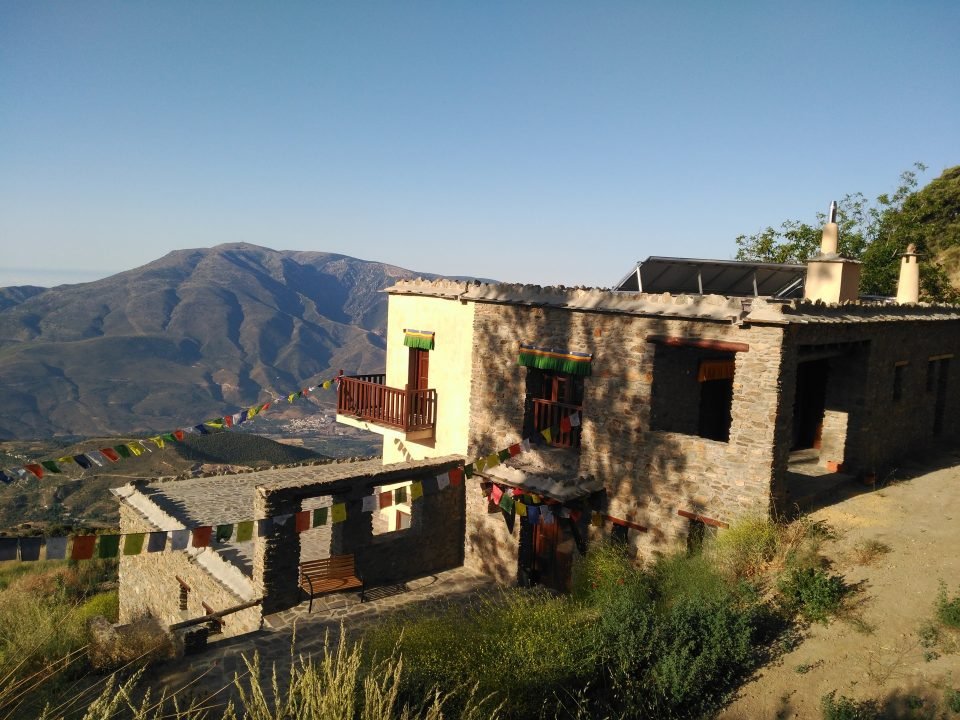
A view of the new O.Sel.Ling Nunnery building at O.Sel.Ling Centro de Retiros, Spain
“There are many who desire enlightenment in a man’s body, but none who work for the benefit of sentient beings in the body of a woman. Therefore, until samsara is empty, I shall work for the benefit of sentient beings in a female body.” — Arya Tara
A new FPMT nunnery is being created at O.Sel.Ling Centro de Retiros, an FPMT retreat center in Spain. Ven. Joan Nicell, who is part of the nunnery advisory board, shares this update on progress of the nunnery:
Thanks to the hard work and tremendous generosity of a great many people, the project to build a nunnery on the land of O.Sel.Ling Centro de Retiros in southern Spain has finally materialized. A million thanks to all the people who helped and supported this project! In particular, our gratitude goes to the director of O.Sel.Ling, Anne Wenaas, who has worked tirelessly to realize this project and has also enabled O.Sel.Ling to contribute financially to its development, and to the late Isabel Arocena, a long time FPMT student, whose generosity allowed the building to be quickly finished just in time for Lama Zopa Rinpoche to bless the nunnery during his visit to O.Sel.Ling in May 2019.
O.Sel.Ling is situated in the Sierra Nevada, a mountain range about forty kilometers (twenty-five miles) from the Mediterranean coast, and within easy traveling distance of Granada. The retreat center covers a large portion of the top of a mountain within a national park and has a spacious view over the wide valley below out to the distant sea.
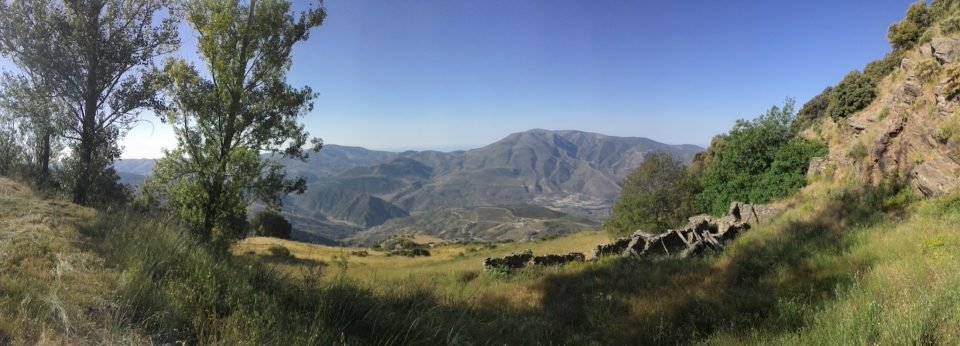
Scenery around O.Sel.Ling, Spain
The new nunnery building is located on the side of the hill just below the large Tara statue. It consists of a gompa, eleven single rooms, a combined library and sitting room, a shared kitchen and dining room, and a large open terrace.
Rinpoche’s more recent advice includes building a Tibetan-style entrance gate, as well as adding Tibetan-style doors and windows, and constructing a beautiful traditional altar for the gompa. We are very lucky to have Peter Griffin, a skilled and experienced artist, working on actualizing this project. Hopefully we will have soon everything we need, including the necessary funds, to fulfill Rinpoche’s wish!
But, now, what the nunnery needs is nuns! Lama Zopa Rinpoche has said that the nunnery should be a place for older nuns to meditate and practice, and for new nuns to engage in studying the Dharma. As Rinpoche has been emphasizing in his recent video advice, in which he calls the Western Sangha in particular “heroes and heroines,” it is of great importance for non-Tibetan Sangha to have conducive places to live, where they can keep their morality pure and dedicate their lives to study, contemplation, and meditation.
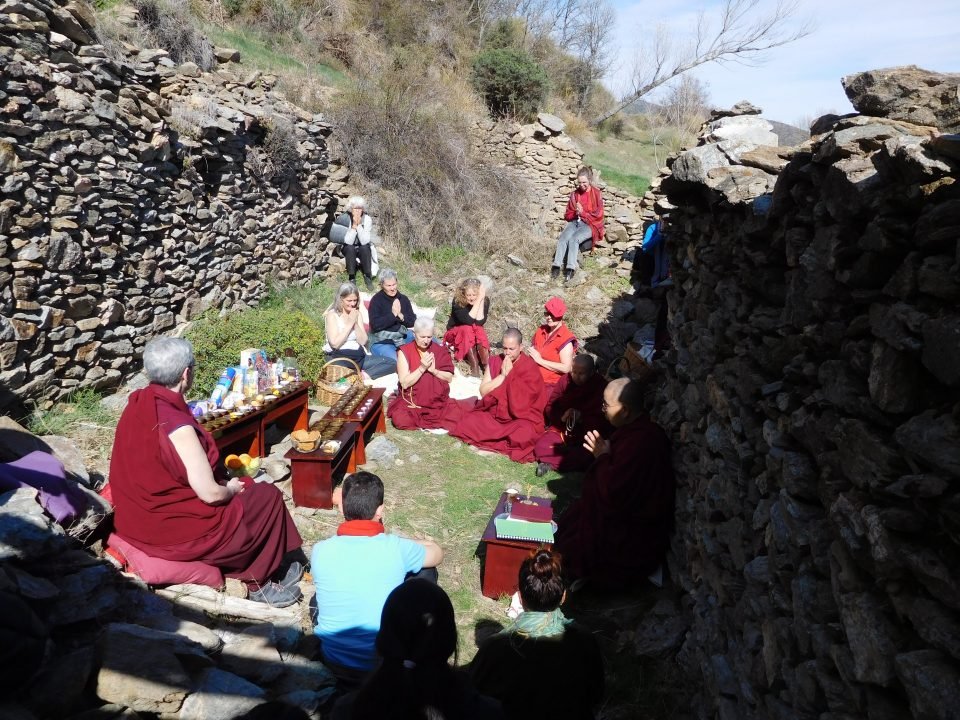
Geshe Jampel, from Nalanda Monastery, doing pujas to the landlord spirits and so forth at the old ruins before starting the construction of the new nunnery building; almost all of the FPMT the Spanish nuns were present for the pujas as well as O.Sel.Ling volunteers and friends, O.Sel.Ling Centro de Retiros, Spain, 2017
Living together in a monastic setting gives Sangha the opportunity to be supported by other Sangha members. In addition, a supportive and caring community helps us deepen our practice. Living according to the Vinaya allows us to take refuge in the Buddhadharma and apply our practice in our daily lives. By nurturing and supporting the Sangha Jewel, we wish to create a community that inspires others to practice Dharma and take ordination for the benefit of all.
Ven. Thubten Khadro, who is currently teaching in New Zealand, was recently appointed as coordinator. She is planning to begin helping the nunnery remotely in August 2021 and hopes to actually go to O.Sel.Ling in May 2022. Rinpoche has also advised two young Russian nuns to come to live in the nunnery and they are currently working on getting the necessary visas. A German nun currently doing retreat in O.Sel.Ling has expressed interest in being part of this new community.
However, we believe it is very important to have some senior nuns join the community. In this way, the less experienced nuns will have the support of more experienced ones. For this reason, we would like to offer FPMT senior nuns the opportunity to come to live, practice, and study the Dharma in this beautiful place. We would be very happy to collaborate with you in creating a community of nuns that can serve as an inspiration for and be of benefit to all sentient beings.
With thanks from the O.Sel.Ling Nunnery Advisory Board: Ven. Sangye Khadro, Ven. Joan Nicell, Ven. Nerea Basurto, and Ven. Marga Echezarreta.
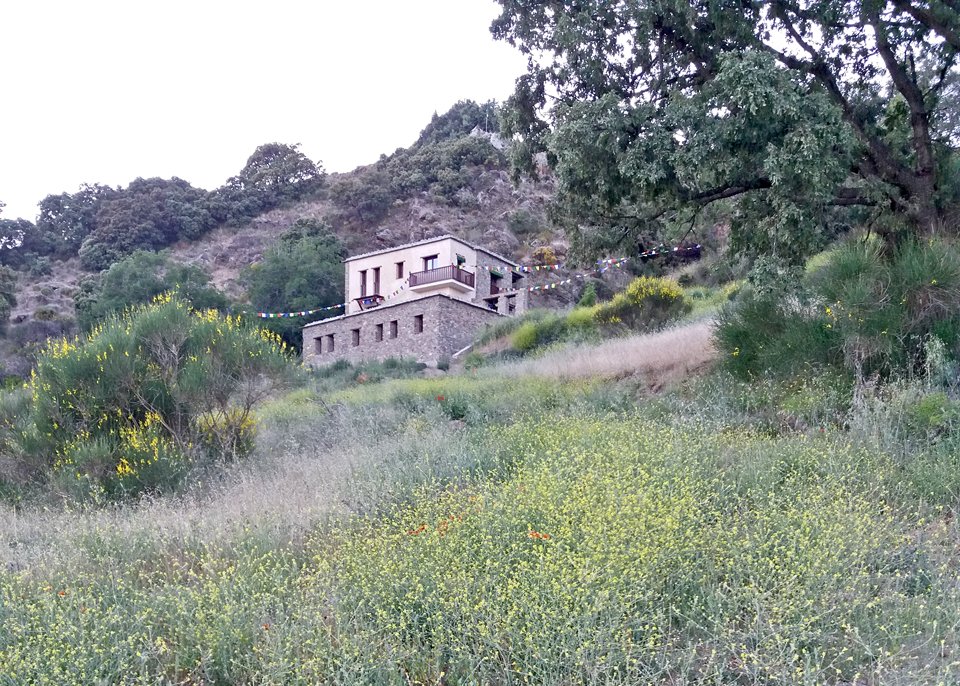
A view of the new O.Sel.Ling Nunnery building from below, O.Sel.Ling Centro de Retiros, Spain
If you are interested in being part of this new Sangha community or if you would like to offer support to completing the building project and furnishing the rooms so that the first nuns can move in, please email monasterio.oseling@gmail.com.
Learn more about O.Sel.Ling Centros de Retiros:
http://www.oseling.org/
FPMT.org and Mandala Publications brings you news of Lama Zopa Rinpoche and of activities, teachings, and events from over 160 FPMT centers, projects, and services around the globe. If you like what you read, consider becoming a Friend of FPMT, which supports our work.
- Tagged: nunnery, o.sel.ling, sangha, ven. joan nicell
9

A Medical University student teaching soup kitchen guests how to properly wash their hands, Ulaanbaatar, Mongolia, October 2020. Photo courtesy of Lamp of the Path.
In 2005, the FPMT center in Ulaanbaatar, Mongolia, Ganden Do Ngag Shedrup Ling, organized a nonprofit organization, Lamp of the Path, to take over the center’s social welfare activities. Community Service is one of FPMT’s Five Pillars of Service. Center director Ianzhina Bartanova shares about their current projects.
Lamp of the Path’s main soup kitchen has been closed almost continuously since the beginning of 2021. We were able to re-open for a short time, only to have to close again due to COVID restrictions. Nevertheless, we continued to offer support to one of the most vulnerable communities of Mongolia, the Mongolian Blind’s People’s Association.
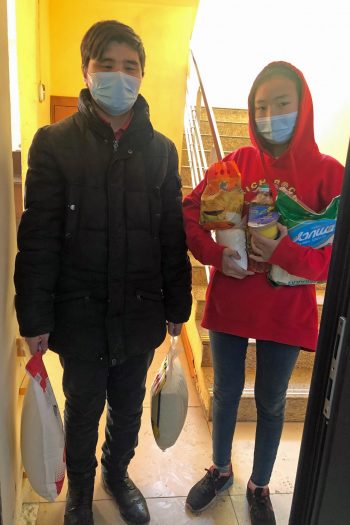
Mongolian Blind People’s Association member and his sister receiving food support from Lamp of the Path, Ulaanbaatar, Mongolia, February 2021. Photo courtesy of Lamp of the Path.
In January 2021, we began helping families by providing food and essential coal supplies. Most of the seventy-five families we have helped live in a ger district. This means they have one felt tent to share with up to seven family members. The Mongolian government provides visually impaired citizens with a small monthly stipend of approximately US$105 per person.
One of our beneficiaries, Ms. Oyunbat, lives with her daughter and two nieces in one apartment. Her daughter is unemployed and looks after the children. Another beneficiary, Ms. Enkhtuya, is living with her son, daughter-in-law, and three grandchildren. Her son’s income is unstable, and life is quite challenging for the entire family.
The visually impaired members who are employed often work at massage salons, sell handmade goods, or work at the Mongolian Blind People’s Association. Multiple lockdowns have made it impossible for them to earn any extra income. They haven’t received much assistance from the government—just a reduction in utility fees and a discount on the price of coal.
Things are even more challenging for elderly people and those who are living alone. Social workers have few opportunities to visit them due to social distancing rules. We are very delighted to be able to provide some help to this vulnerable community. The Mongolian Blind People’s Association expressed their heartfelt gratitude for our timely and essential support and shared about our efforts on their website.
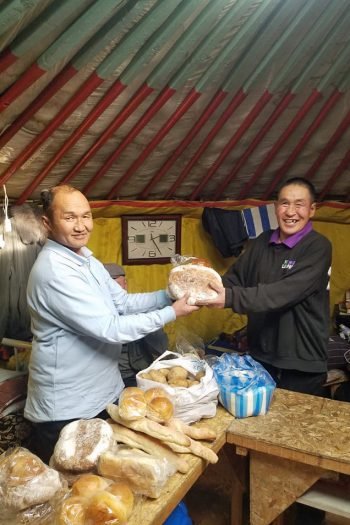
Amgalan residents receiving food support from Lamp of the Path, Ulaanbaatar, Mongolia, January 2021. Photo courtesy Lamp of the Path.
Amgalan, another of our long-term nonprofit partners, offers shelter to former alcoholics and the homeless. We recently provided substantial food supplies to eighteen residents. We were pleased to learn that our partner 12th khoroo District will receive some help from the government. Lamp of the Path is located in the 12th khoroo District and we feel very connected to people living there.
In 2020, we began a new project in cooperation with government social workers. Every week, a social worker or someone from our group visited five poor families. We delivered food items from lists prepared by the social workers. When we didn’t receive any requests this year we inquired, and learned they are now receiving government help. We hope the government will expand their efforts and reach more people in need.
We visited hundreds of family households and observed that many are headed by single mothers. We have decided to focus on helping single mothers this year as much as we can.
When we briefly opened our soup kitchen, we observed our guests didn’t know how to properly wash their hands to prevent the spread of COVID-19. They would touch the tap water for a few seconds and then consider their hands clean. We invited medical students to offer an informative seminar, “Diseases Communicated through Unclean Hands.” The medical students spoke about diseases spread by unclean hands, conditions that require handwashing, and handwashing techniques. The audience had a lot of fun!

Guests enjoying a meal at the soup kitchen while adhering to mandatory social distancing, Ulaanbaatar, Mongolia, March 2021. Photo courtesy of Lamp of the Path.
We are also pleased to share that we have been able to retain our entire staff, and that they continue to receive their full salaries. This is a challenging time around the world, but it has shown us human beings have great potential to act with love and kindness. We can work together to bring great benefit to those in need. We are deeply grateful to all our supporters, and we wish them all the best!
We plan to further serve our community this year by continuing our collaborations with the Enerel Clinic, International School of Ulaanbaatar, Medical University, the Mongolian Blind People’s Association, government social workers serving the 12th and 23rd khoroos of Bayanzurkh District, and more.
To learn more about Ganden Do Ngag Shedrup Ling, visit their website:
http://www.fpmtmongolia.org/
The Social Services Fund was honored to offer US$29,400 to this incredible project this year. Since 2012, thanks to a generous donor and the support of many, we have offered over US$246,000 to the Lamp of the Path program.
FPMT.org and Mandala Publications brings you news of Lama Zopa Rinpoche and of activities, teachings, and events from over 160 FPMT centers, projects, and services around the globe. If you like what you read, consider becoming a Friend of FPMT, which supports our work.
- Tagged: community service, community-social service pillar, ganden do ngag shedrup ling, ianzhina bartanova, mongolia, mongolian blind people's association, soup kitchen
2
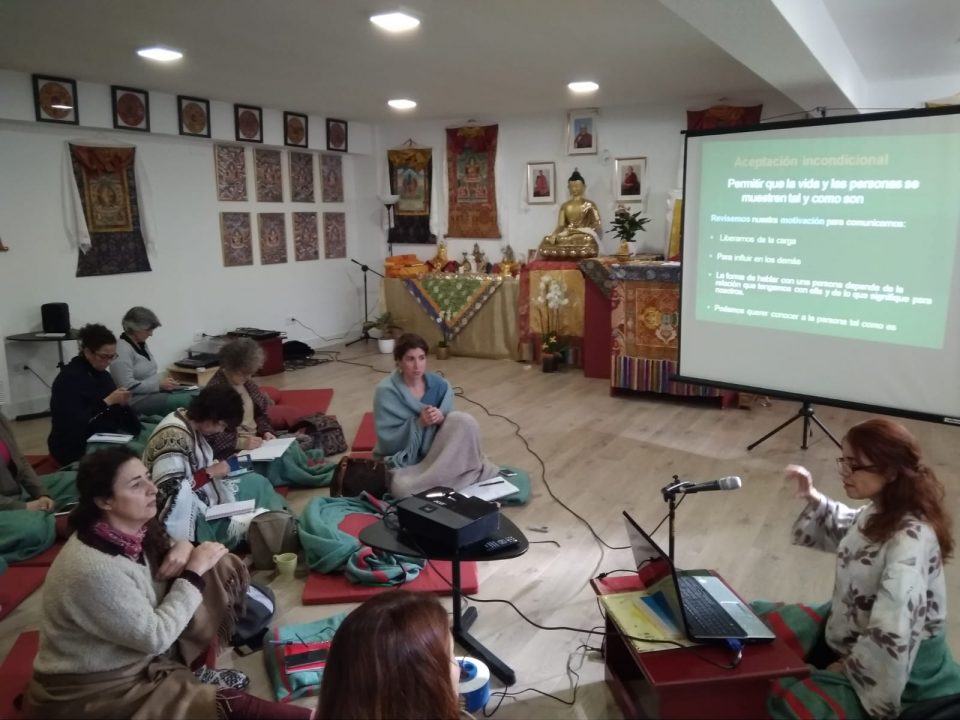
Volunteer training course class taught by Alexandra Mejia at Centro Nagarjuna Madrid, Spain, February 2019. Photo courtesy of Alexandra Mejia.
La Asociacion Potala Hospice (Potala Hospice Association) is one of FPMT’s hospice services offering service to the community during the COVID pandemic. Community Service is one of FPMT’s Five Pillars of Service. Alexandra Mejia, coordinator, shares the story.
La Asociacion Potala Hospice began its journey in December 2000, one month after a group of students had the opportunity to meet Lama Zopa Rinpoche on Tenerife, one of the Canary Islands. Rinpoche told me it would be good to organize a group of people at Nagarjuna C.E.T. Madrid, an FPMT center, who were interested in the subject of death so we could accompany and support people who are dying. Rinpoche advises me to learn everything I could from the work done by Ven. Thubten Pende (Ken Hawter), founder of Karuna Hospice Service, an FPMT project in Queensland, Australia. This is how, under the inspiration and advice of our precious Lama Zopa Rinpoche, we began to meet once a week. In May 2003, we became a registered nonprofit organization in Spain. Our organization’s name was given to us by our dear Rinpoche.
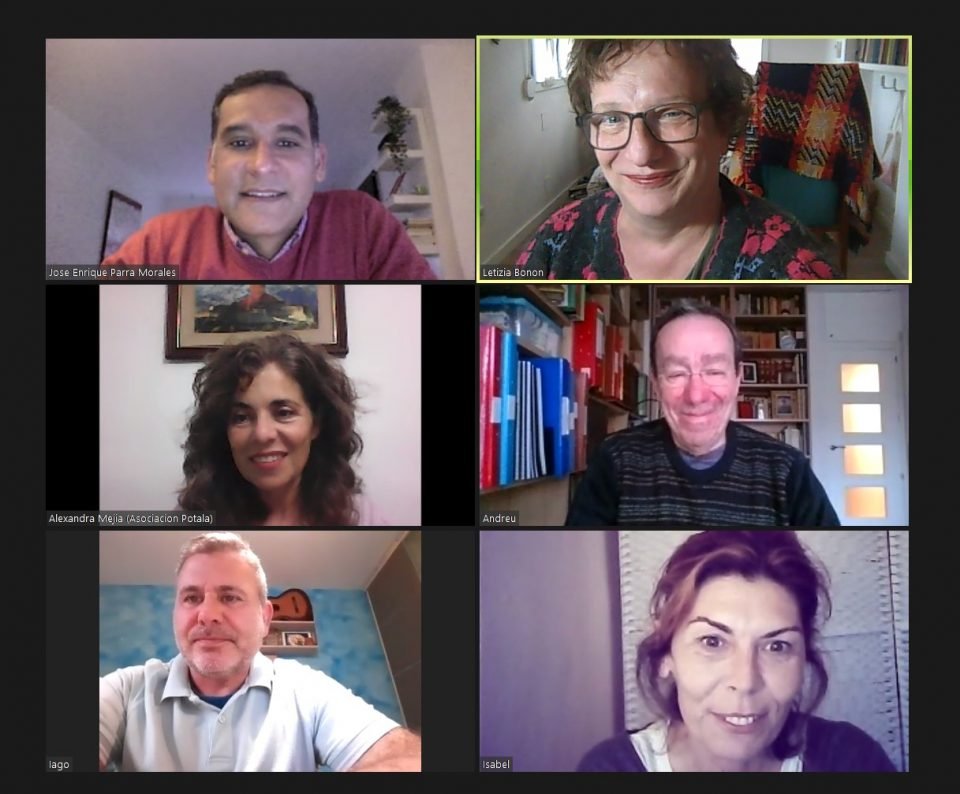
La Asociacion Potala Hospice board members Jose Enrique Parra, Leticia Bonon, Alexandra Mejia, Andreu Stany, Iago Carbonell, and Isabel Picaso meeting on Zoom, April 2021. Photo by Alexandra Mejia.
In 2007, we signed a collaboration agreement with Hestia Hospital in Madrid to accompany patients in the palliative care unit. Since then, hundreds of people have become La Asociacion Potala Hospice volunteers and have completed one of the training courses we periodically offer. Our organization continues to grow. We formed a volunteer group in Valencia in November 2019 and a group in Barcelona in December 2020.
Our organization’s main function has been face-to-face volunteering. The volunteer plays an important role in hospitals, and their work is well-recognized, accepted, and appreciated among hospital staff. Illness from disease creates a situation that favors the emergence of questions in the human mind. The tedious hours spent hospitalized, the beginning of gradual and irrecoverable losses, the difficult encounter with fragility and dependence on others, the feelings of powerlessness that follow, and the senselessness of suffering raise questions connected with our spiritual dimension. Our physical needs to eat, sleep, drink, and breathe are normally satisfied by objects, but a person’s spiritual needs can only be satisfied by another human being. Our need for affection, contact, respect, reconciliation, and hope can never be satisfied by a machine, drug, or concept. Volunteers, through their presence and support, help the sick find hope.

Zoom volunteer training class on how to offer telephone support during COVID, May 2020. Photo by Iago Carbonell.
Our volunteers are people who, through their own motivation of solidarity, sought out training to develop the knowledge, skills, and attitudes they need to accompany the patient at the end of life. When COVID broke out, our volunteers were engaged in this work in Madrid, Valencia, and Barcelona, and we had plans to begin collaborating with new institutions. However, due to COVID, volunteering is not allowed in the hospitals in Spain.
We reinvented our activities so we can continue with our main objective, which is to accompany people in their suffering through illnesses and death. In 2020, we maintained cohesion among our volunteers by training them to offer telephone support for people affected by COVID. We met weekly by Zoom during the months of April, May, and June. We wanted to maintain communication between ourselves and support each other, while also continuing to train ourselves through participation in workshops on the subject of death, dying, and accompaniment.
While hospitals are still closed to volunteers, we continue to help the community by offering workshops on death via Zoom to the FPMT Hispana community. We also increased our social media presence, launching a Facebook page and Instagram account to share helpful content.
To learn more about La Asociacion Potala Hospice, visit their website:
https://www.potalahospiceluzclara.org/en-au
FPMT.org and Mandala Publications brings you news of Lama Zopa Rinpoche and of activities, teachings, and events from over 160 FPMT centers, projects, and services around the globe. If you like what you read, consider becoming a Friend of FPMT, which supports our work.
28
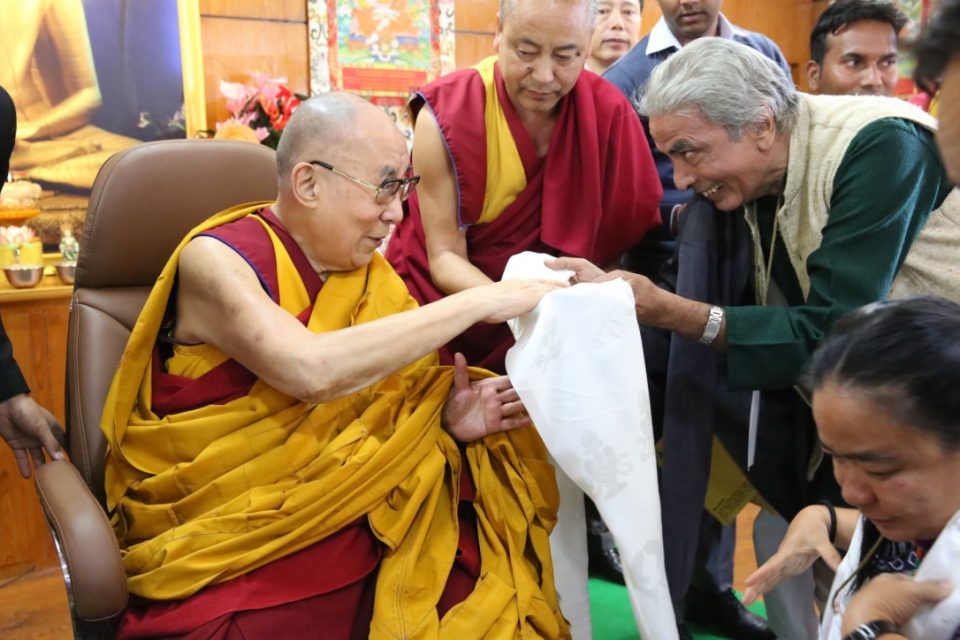
His Holiness the Dalai Lama with Naresh Mathur. Photo courtesy of the Office of His Holiness the Dalai Lama.
We are saddened to share the news that Naresh Sahai Mathur passed away at the age of 67, in New Delhi, India, on April 25, 2021, of COVID-19. Naresh was an early student of FPMT founders Lama Thubten Yeshe and Lama Zopa Rinpoche, and a long-time FPMT volunteer. Kabir Saxena, also a long-time FPMT student who currently serves as the spiritual program coordinator at Tushita Mahayana Meditation Centre in New Delhi, wrote a personal remembrance of Naresh to share with the international FPMT community.
By Kabir Saxena
With the recent untimely passing away of Naresh Mathur—another victim of the second murderous wave of COVID-19—the Indian Buddhist sangha, his friends worldwide, as well as the Tibetan community, have lost an invaluable supporter, legal advisor, and much beloved friend.
Naresh was born in Old Delhi in 1954, close to where some twenty-five years later the pioneers of Tushita Mahayana Meditation Centre would be living. It’s a testimony to his great intellectual and spiritual thirst that he was willing and able to seek beyond his quality education in sociology and law at two of Delhi’s esteemed establishments and find himself at the doors of both Tushita Mahayana Meditation Centre and Tibet House in Delhi.
While the practice of law provided his bread and butter, it was Buddhist studies that quickly established their prominence in Naresh’s heart and mind. Early on he had the great good fortune to receive personal, one-on-one teachings on lamrim and Madhyamaka from the renowned Geshe Palden Drakpa, who became a lifelong friend of the family and a recipient of Naresh’s generous medical help. It was, I believe, this deep experience of the teachings with Geshe-la that made Naresh a lifelong proponent of the sublime Nalanda parampara (tradition), with its emphasis on the guru-disciple relationship, logical inquiry, and debate. It was to these teachings that Naresh returned again and again; even in the last decade of his life, he was an important part of the core group of students at Geshe Dorji Damdul’s Tibet House Nalanda Masters Course.
Naresh was a lover of knowledge, a philosopher in the true sense of the word, and all his life he combined that with his work as a lawyer in the High and Supreme Courts in Delhi.
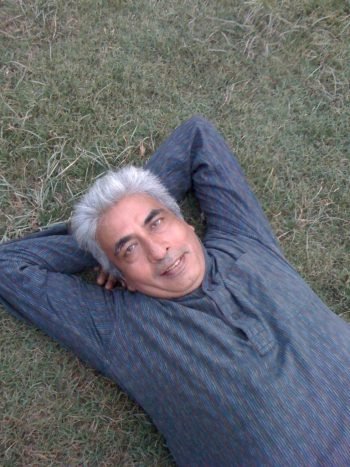
Naresh Mathur
When I first met him in 1980, he was a bright and extremely handsome young man, much impressed by his contact with Lama Thubten Yeshe and Lama Zopa Rinpoche. Naresh went on to be a director of Tushita Mahayana Meditation Centre, an organizer of the Dharma Celebrations with His Holiness the Dalai Lama in Delhi, and the creator of Root Institute for Wisdom Culture’s Trust Deed in 1984 in Bodhgaya. He remained a trustee until a few months before his death.
His dedication to the cause of bringing the Dharma back to Indian people was profound and lasting. He participated in the teachings His Holiness gave to small groups of Indian students in the early 1980s and despite his heavy workload would, almost thirty years later, travel to Bodhgaya for the weekends to give teachings in Hindi to local students.
Naresh unstintingly helped the Tibetan cause with his legal talents and the list of his efforts on their behalf would be too long to include here. As an example, it was largely due to his legal actions that the Tibetan Colony of Majnu Ka Tila in Delhi was saved from destruction. Tenzin Geyche Tethong, former secretary to His Holiness, recalled how he had known Naresh since 1980 and how he greatly admired his interest in and knowledge of Buddhism, and also appreciated Naresh’s contribution to the Dalai Lama Trust of which he was a trustee.
In addition to his connection with Lama Yeshe, Lama Zopa Rinpoche, and FPMT, Naresh had a close connection with Dzongsar Jamyang Khyentse Rinpoche and his Deer Park Institute in Bir, as well as with Samdhong Rinpoche, whose Gandhian vision, critique of modernity, and Dharma advice were like nectar for Naresh.
Naresh was a lover of the meditative dhrupad style of Indian classical music, and we also spent many happy moments listening to Bob Dylan together. He could also be quite mischievous, and we would especially enjoy making silent and secret fun of speakers at conferences whom we considered not up to the mark.
He was a practitioner, especially of the Madhyamaka and the Kalachakra, and was increasingly drawn to extended practice in the last year of his life, according to his wife, Antonella. Throughout his life he had inspired and encouraged a younger generation of students by his example.
For me, and I am sure for many others, including his dear circle of Italian and international friends, Naresh was like family. His deep soulful eyes were those of the eternal seeker and lover; they grabbed you. My father, to whom Naresh was very loving and generous, used to say that going by Naresh’s piercing gaze, he was always in a state of otherworldly intoxication!
In his last year, during long walks together in the woods near his home in south Delhi, Naresh would always steer the conversation to the Dharma, the importance of a grounding in lamrim, and his great love and obsession: the presentation of emptiness in the Gelug tradition. Despite his allegiance to many lamas of different schools of Tibetan Buddhism, he always seemed to be happily and no doubt karmically tethered to the pole of Lama Tsongkhapa’s works and Geshe Palden Dragpa’s teachings.
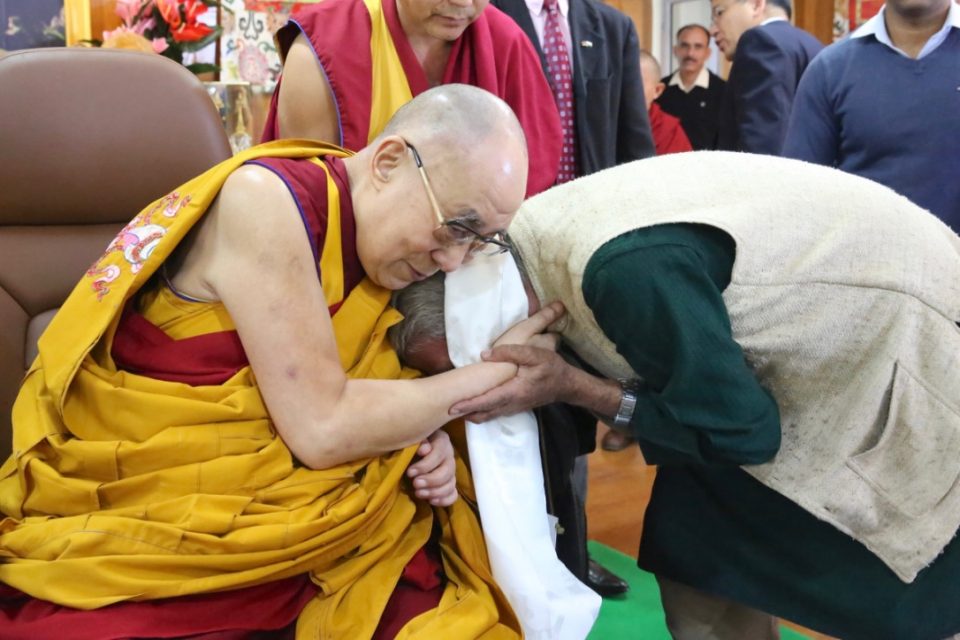
His Holiness the Dalai Lama with Naresh Mathur. Photo courtesy of the Office of His Holiness the Dalai Lama.
After his passing, His Holiness the Dalai Lama made the encouraging pronouncement that Naresh was his disciple, that we should not worry, and that he would take a good rebirth and would remember this life of his. The passing of this kind-hearted and generous man, still somewhat unreal and unbelievable to some of us, leaves a big void in many lives. Naresh is survived by his wife, Antonella, a gifted healer; daughter, Mudita, a talented graphic designer; and son, Atisha, a profound, upcoming teacher of the Dharma, especially of Buddhist logic, the subject matter his dear departed father so admired and communicated so readily to those fortunate enough to cross his path.
The FPMT India community organized a moving online prayer meeting and memorial for Naresh Mathur on May 5, 2021, with Naresh’s family and many long-time students around the world joining in. You can watch the two-hour recording of the Zoom call:
https://www.facebook.com/1652241455007411/videos/457118005515720/?__so__=channel_tab&__rv__=all_videos_card
For more on practices recommended by Lama Zopa Rinpoche at time of death and other resources to support yourself and loved ones at time of death, please visit fpmt.org/death/.
FPMT.org and Mandala Publications brings you news of Lama Zopa Rinpoche and of activities, teachings, and events from over 160 FPMT centers, projects, and services around the globe. If you like what you read, consider becoming a Friend of FPMT, which supports our work.
- Tagged: kabir saxena, naresh mathur, obituaries, ven. kabir saxena
25
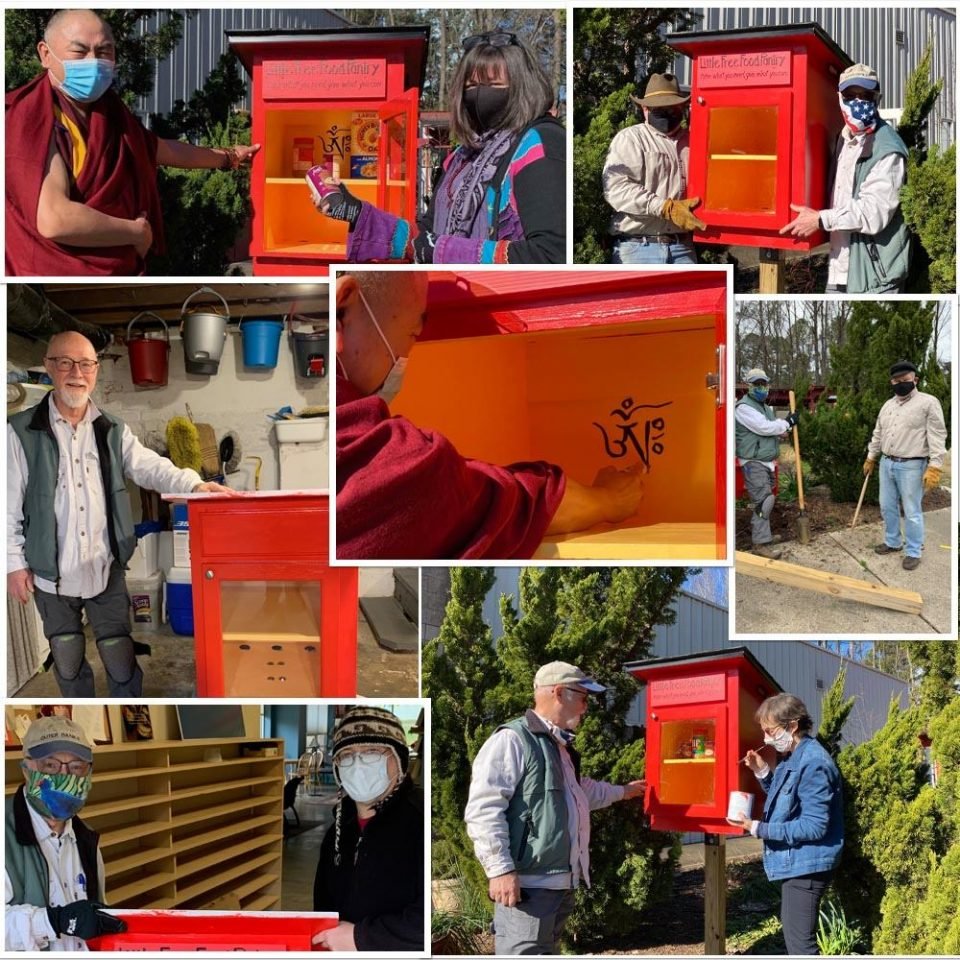
Geshe Palden Sangpo, Sandy Carlson, Paul Krebbs, David Strevel, Joey Gooch, and Elise Strevel with the Little Free Pantry at Kadampa Center, Raleigh, North Carolina, US, January 2021. Photo collage by Sandy Carlson.
Kadampa Center, an FPMT center in Raleigh, North Carolina, US, created a Little Free Pantry to offer food and other items to people in need. Community Service is one of FPMT’s Five Pillars of Service. Sandy Carlson, Kadampa Center board of directors president and volunteer, shares the story.
“Give what you can, take what you need”—this is the mantra of the Little Free Pantry. Nestled between two bushy evergreen trees, the bright red box at Kadampa Center invites any passerby to open its door and find what they need, whether it’s food, toiletries, or paper goods.

Little Free Pantry at Kadampa Center, Raleigh, North Carolina, US, March 2021. Photo by Sandy Carlson.
The Little Free Pantry is a movement of neighbors helping neighbors. It’s about people reaching out to others, town by town, throughout the world. Following the idea of Street Libraries, Little Free Pantries offers items to meet basic human needs, accessible to everyone all the time, no questions asked.
The current pandemic, with the economic stresses that accompany it, inspired members of the Kadampa Center community to create our own Little Free Pantry. Filled with cans, jars, and boxes of food, it not only helps our neighbors, but also allows our members to practice loving kindness, compassion, and generosity.
Already, after only a few months, we have seen evidence that we are fulfilling a need for the food and toiletries that pass through our new Little Free Pantry, even though we are not physically open for classes.
The pantry arose through the help of many people who brainstormed the best location (keeping in mind discretion, visibility, and awareness of the exposure to sun and weather), provided carpentry work (remodeling a used kitchen cabinet from Habitat for Humanity), and painted and placed the pantry when it was ready.
One of our FPMT resident teachers, Geshe Palden Sangpo, performed a beautiful blessing, and he has started painting mantras in the pantry. Geshe Sangpo also donated the very first items of food.
Watch the four-minute video “Geshe Sangpo Blessing Little Free Pantry” on the Media Kadampa Center YouTube channel:
https://youtu.be/slP9rKi3-C8
We so appreciate all our members who helped bring this awesome project to life: Elise and David Strevel, Diane Meyer, Paul Krebbs, Joey Gooch, and Sandy Carlson. We also send much love and appreciation for those in our community who continue to keep our Little Free Pantry full of items for anyone in need. This truly is compassion in action.
To learn more about Kadampa Center, visit their website:
https://kadampa-center.org/
FPMT.org and Mandala Publications brings you news of Lama Zopa Rinpoche and of activities, teachings, and events from over 160 FPMT centers, projects, and services around the globe. If you like what you read, consider becoming a Friend of FPMT, which supports our work.
- Tagged: community service, community-social service pillar, elise strevel, geshe palden sangpo, kadampa center, sandy carlson
6
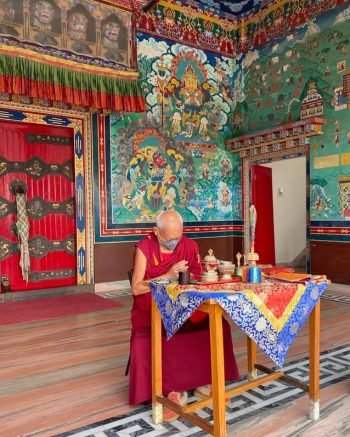
Rinpoche offering incense puja at Kopan Monastery, Nepal, May 2021. Rinpoche is offering these pujas to help all those suffering due to COVID-19, particularly all those in India, Nepal (including in Kopan Monastery and Nunnery), and throughout the world.
As we shared last week, there has been a COVID-19 outbreak at Kopan Monastery and Nunnery in Nepal. The latest information from Kopan is that unfortunately more people at Kopan Monastery have tested positive for COVID. Currently, there are four Kopan monks in the hospital in Kathmandu with COVID-19.
One of those monks is Geshe Thubten Sherab, the FPMT resident teacher at Thubten Norbu Ling Tibetan Buddhist Center in Santa Fe, New Mexico, US, who is in Nepal. Geshe Sherab was taken to the hospital in order to have oxygen available to help with his COVID-related breathing difficulties. Geshe Sherab talked with Ven. Roger Kunsang earlier today and Geshe Sherab says he is not needing oxygen at this time and is doing better. Many FPMT centers and regional and national offices—including Thubten Norbu Ling and FPMT Australia—are organizing prayers for Geshe Sherab and Kopan Sangha.
Lama Zopa Rinpoche is continuing in isolation at Kopan Monastery. Rinpoche is still in good health and has been continuing to offer incense and other pujas to help the situation with COVID-19 in India, Nepal (including at Kopan), and the rest of the world.
The Kopan community would like students to know that they are committed to keeping each other as safe as possible and are so appreciative of everyone’s good wishes and prayers. As we mentioned in our previous blog on this situation, Kopan is requesting that the monastery not be contacted at this time unless there is an emergency.
Thanks to so many of the FPMT family who are continuing to keep all at Kopan Monastery and Khachoe Ghakyil Nunnery, as well everyone affected by the pandemic, in their prayers.
You can find Lama Zopa Rinpoche’s advice for this critical time on our Resources for the Coronavirus Pandemic page.
Watch videos from the series Lama Zopa Rinpoche’s Teachings on Thought Transformation during the Time of COVID-19 and find links to videos in transcripts, MP3s, additional practice advice, and more:
https://fpmt.org/fpmt/announcements/resources-for-coronavirus-pandemic/advice-from-lama-zopa-rinpoche-for-coronavirus/
FPMT.org and Mandala Publications brings you news of Lama Zopa Rinpoche and of activities, teachings, and events from over 160 FPMT centers, projects, and services around the globe. If you like what you read, consider becoming a Friend of FPMT, which supports our work.
- Tagged: coronavirus, covid-19, geshe thubten sherab, khachoe ghakyil ling, kopan monastery, lama zopa rinpoche
26
Here’s a short excerpt of the story that looks at how centers moved their Dharma programs online last year:
“For center directors, it quickly became clear that many things that had been done in the center’s gompa could be moved online.
“Paula [de Wijs, director of Maitreya Instituut in the Netherlands] writes, ‘For years we had discussed doing more on the internet or through YouTube but had never really managed to put these ideas into practice. The expertise and equipment were not available and there was no real need to acquire either of them. Although many of us had used Zoom or other virtual meeting sites to attend meetings with people internationally, we had never considered holding teachings and meditations through such a medium. Suddenly this possibility became a necessity and we were able to continue the meditations and teachings without a break. That was a great relief on that score, since making the teachings of the Buddha accessible to people is our raison d’être: it is why we exist.’
“Center staff around the world studied and mastered Zoom and began to stream most of their regular teachings online. ‘I was amazed and impressed by how quickly this happened!’ Drolkar McCallum, who is the FPMT regional coordinator for North America, commented in April [2020].
“With the shift to online, some centers were seeing larger audience for their teachings. For example, Land of Joy in the UK, hosted an online retreat with Paula Chichester that had 130 participants.
“Mauricio Roa, who serves as the regional coordinator for Latin America, reported, ‘Centers who were used to having only a few members at classes, teachings, retreats, etc., multiplied their number of participants with their online offerings.’ Mauricio shared an example of a class given by Ven. Robina Courtin, teaching from the United States, offered through Centro Shiwa Lha in Brazil, which had 600 participants. Centers also started hosting retreats online. Some centers created different options for attending retreats, allowing different levels of participation. This flexibility also made it possible for more people to attend. And because of all the shut downs, some students reported that they found they were able to go deeper with their practices at home.“
Read the complete story in “Centers, Projects, and Services during the Pandemic: Turning a Difficult Situation into a Positive Result.”
Read more from Mandala 2021.
FPMT.org and Mandala Publications brings you news of Lama Zopa Rinpoche and of activities, teachings, and events from over 160 FPMT centers, projects, and services around the globe. If you like what you read, consider becoming a Friend of FPMT, which supports our work.
- Tagged: fpmt organization
22
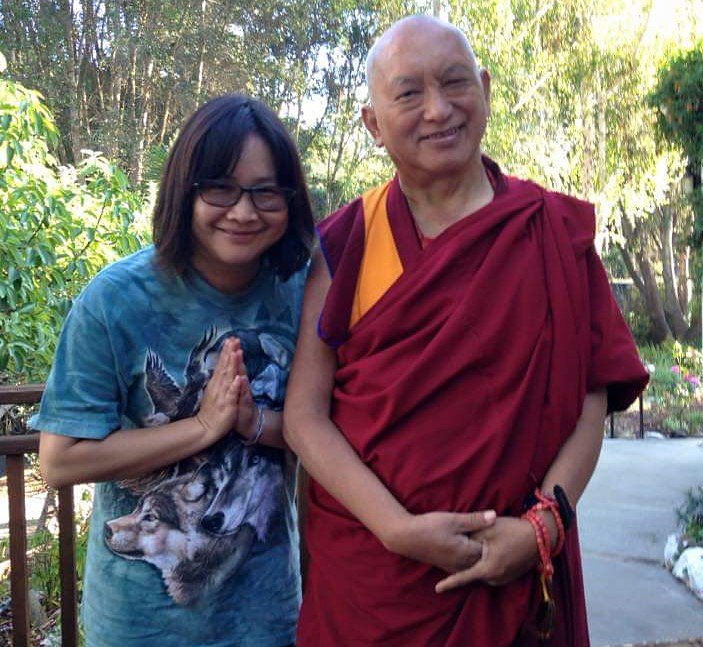
Lama Zopa Rinpoche with Monica Hung, Aptos, California, US, 2016. Photo courtesy of Monica Hung.
Tse Chen Ling, the FPMT center in San Francisco, California, US, has expanded their offerings with a new class. Ven. Carol Corradi, center director, and Monica Hung, interpreter and teacher, share the story.
In March 2020, our center embarked in a new direction with “What Is Buddhism,” a class offered in Mandarin with staff member Monica Hung. The class met an hour each week until the COVID-19 epidemic forced closure of the center. Soon after, the class regrouped and moved to an online format via Zoom.
Most of the students in the class are originally from China and grew up with no experience of Tibetan Buddhism. Their understanding of Buddhism in general is a cultural one, mostly of temples and a tradition of making offerings without any practice or doctrinal aspects.
The “What Is Buddhism” class was born out of a Chinese New Year event sponsored by our center in 2020. We celebrated Chinese New Year with an Open House at the center with some traditional sweets and a chance for visitors to offer incense. Visitors could also sponsor special light offerings for family, friends, and loved ones who had passed away. Besides fostering a more cordial connection with the neighborhood, individual conversations lead to some questions about Tibetan Buddhism. Those conversations sparked the idea for this class.
Monica shared that she presents a broad overview of Tibetan culture and history. This helps students understand the background of Tibetan Buddhism. She also provides a basic introduction to Buddhist terminology. The class is conducted in a discussion-like style. The casual environment encourages students to feel free to ask any kind of question about Tibetan Buddhism. Some examples are “As a Buddhist do I need to become a vegetarian?” and “Can lamas marry?”
Each class opens with the group reading the Heart Sutra together and then doing about three minutes of meditation on the breath.
One of the students recently asked about the meaning of the Heart Sutra. This became an opportunity for Monica to play His Holiness the Dalai Lama’s teaching on the Heart Sutra, which originally aired online in January 2021. The class watched the video together. Monica paused it periodically to explain some of the more advanced terminology for them. This has become part of the regular class with Monica and the students watching His Holiness the Dalai Lama’s online teaching, discussing, and slowly moving through the complete teaching over several classes.
Monica plans to begin introducing the students to the lamrim teachings in the spring of 2021. Our center is looking at ways to publicize the class locally, hoping to make the class more widely available to our Chinese-speaking neighbors.
To learn more about Tse Chen Ling, visit their website:
https://www.tsechenling.org/
FPMT.org and Mandala Publications brings you news of Lama Zopa Rinpoche and of activities, teachings, and events from over 160 FPMT centers, projects, and services around the globe. If you like what you read, consider becoming a Friend of FPMT, which supports our work.
- Tagged: mandarin, monica hung, tse chen ling, ven. carol corradi
13
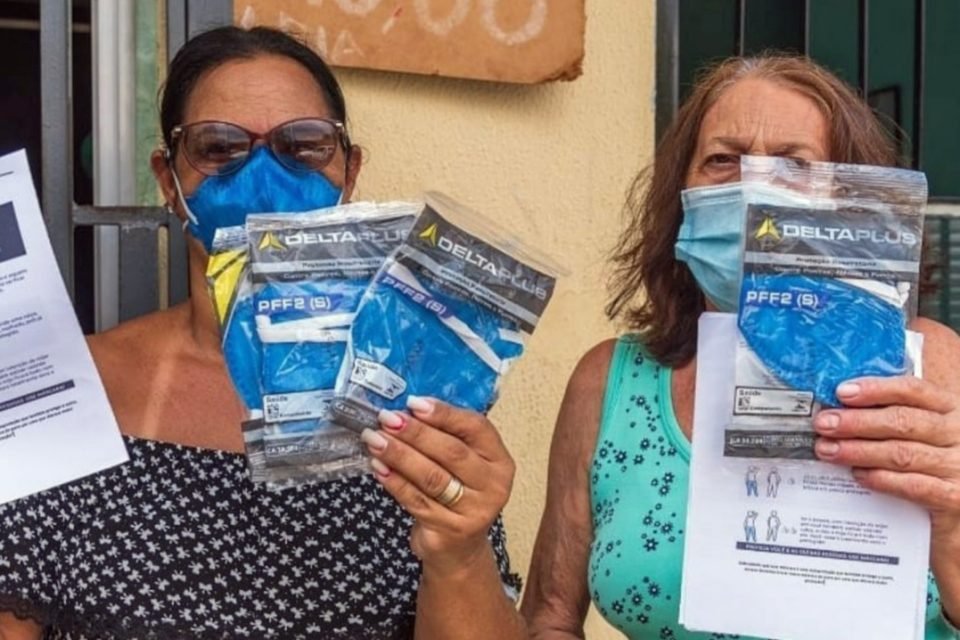
Masks and instructions delivered to Vozes da Comunidades in Rio de Janeiro, Brazil, March 2021. Photo by Selma Souza.
In March 2021, Centro Shiwa Lha, the FPMT center in Rio de Janeiro, Brazil, began facilitating the distribution of high quality face masks and instructions to the nonprofit organizations Instituto Floriano Peçanha dos Santos, Vozes da Comunidades, and Apadrinhe um sorriso in Rio de Janeiro, and the parish of Brazilian Catholic priest Padre Júlio Lancellotti. They did this as Brazil’s COVID-19 crisis continues to worsen. The PFF2 masked that were distributed are similar to other high quality face masks sold in various parts of the world (such as the N95, FFP2, KN95, P2, and DS2). Community service is one of FPMT’s Five Pillars of Service. Ven. Tenzin Namdrol, center director, shares the story of how Centro Shiwa Lha has offered help during this ongoing crisis.

Masks and instructions delivered to Instituto Floriano Peçanha dos Santos in Rio de Janeiro, Brazil, March 2021. Photo by Thalita Garcia.
The purpose of the Masks for All campaign was to donate face masks to people who cannot afford the PFF2 models, the face mask sold in Brazil that really provides security. People received donated masks and material with instructions on how to put them on, remove them, and reuse them without lessening their effectiveness.
The campaign began with one practitioner who wanted to donate around 2,000 face masks, and from there many others joined.
We offered a total of 4,020 masks to three nonprofit organizations in Rio de Janeiro as well as to Father Julio Lancelloti who supports people who live on the streets in São Paulo city. The company that sold us the masks was inspired by our campaign and offered forty liters (eleven gallons) of alcohol gel for hand sanitizing to the nonprofit organizations.
We thank all of the donors who have given us this opportunity to serve the community at such a crucial time.
To learn more about Centro Shiwa Lha, visit their website:
https://shiwalha.org.br/
FPMT.org and Mandala Publications brings you news of Lama Zopa Rinpoche and of activities, teachings, and events from over 160 FPMT centers, projects, and services around the globe. If you like what you read, consider becoming a Friend of FPMT, which supports our work.
7
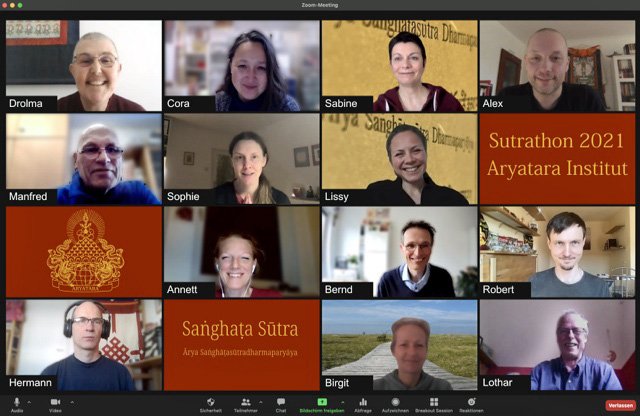
Online Sutrathon by Aryatara Institut, March 2021. Photo by Alex Volk.
Aryatara Institut, the FPMT center in Munich, Germany, held a twenty-four hour Online Sutrathon to thank the individuals who donated to the center in February 2021 during the Fifteen Days of Miracles. Sabine Kehl, a long-term member of the center who translates for the center, shares the story.
In 2021, as we do every year during the Fifteen Days of Miracles—starting on Losar and ending on Chotrul Duchen—our center held a fundraising campaign. We gave friends and supporters the opportunity to accumulate merit in the form of generosity. Generosity is one of the six paramitas, one of the practices of the six perfections. By practicing generosity and donating to the center, students can contribute to the preservation of Aryatara Institut and the spreading of the Dharma.
We received an incredible grand total of €8,773.82 (US$10,511) from sixty donors. Please rejoice with us!
We expressed our gratitude with an Online Sutrathon. Beginning on Friday, March 5, at 4 p.m., thirteen people recited the Sanghata Sutra nonstop for twenty-four hours. The group, which consisted of members of our board of directors and friends of our center, recited the Sanghata Sutra by taking turns every hour. Anyone could join the Online Sutrathon by reading along live via Zoom or following the Online Sutrathon via YouTube livestream.
The Online Sutrathon began on Friday with a motivation and ended on Saturday afternoon with a dedication of the merits. We dedicated the merits we created for the sake of all sentient beings.
We managed eight full recitations! It was a wonderful and heartwarming experience to be able to offer a big “Thank you” as a community to our donors in this way while also creating great benefit for all sentient beings. We rejoice!
For more information about Aryatara Institut, visit their website:
https://aryatara.de/
FPMT.org and Mandala Publications brings you news of Lama Zopa Rinpoche and of activities, teachings, and events from over 160 FPMT centers, projects, and services around the globe. If you like what you read, consider becoming a Friend of FPMT, which supports our work.
- Home
- News/Media
- Study & Practice
- About FPMT Education Services
- Latest News
- Programs
- New to Buddhism?
- Buddhist Mind Science: Activating Your Potential
- Heart Advice for Death and Dying
- Discovering Buddhism
- Living in the Path
- Exploring Buddhism
- FPMT Basic Program
- FPMT Masters Program
- FPMT In-Depth Meditation Training
- Maitripa College
- Lotsawa Rinchen Zangpo Translator Program
- Universal Education for Compassion & Wisdom
- Online Learning Center
- Prayers & Practice Materials
- Overview of Prayers & Practices
- Full Catalogue of Prayers & Practice Materials
- Explore Popular Topics
- Benefiting Animals
- Chenrezig Resources
- Death & Dying Resources
- Lama Chopa (Guru Puja)
- Lama Zopa Rinpoche: Compendium of Precious Instructions
- Lama Zopa Rinpoche: Life Practice Advice
- Lama Zopa Rinpoche Practice Series
- Lamrim Resources
- Mantras
- Prayer Book Updates
- Purification Practices
- Sutras
- Thought Transformation (Lojong)
- Audio Materials
- Dharma Dates – Tibetan Calendar
- Translation Services
- Publishing Services
- Teachings and Advice
- Find Teachings and Advice
- Lama Zopa Rinpoche Advice Page
- Lama Zopa Rinpoche: Compendium of Precious Instructions
- Lama Zopa Rinpoche Video Teachings
- ༧སྐྱབས་རྗེ་བཟོད་པ་རིན་པོ་ཆེ་མཆོག་ནས་སྩལ་བའི་བཀའ་སློབ་བརྙན་འཕྲིན།
- Podcasts
- Lama Yeshe Wisdom Archive
- Buddhism FAQ
- Dharma for Young People
- Resources on Holy Objects
- Ways to Offer Support
- Centers
- Affiliates Area
- Teachers
- Projects
- Charitable Projects
- Make a Donation
- Applying for Grants
- News about Projects
- Other Projects within FPMT
- Support International Office
- Projects Photo Galleries
- Give Where Most Needed
- FPMT
- Shop
Subscribe to FPMT News
Translate*
*powered by Google TranslateTranslation of pages on fpmt.org is performed by Google Translate, a third party service which FPMT has no control over. The service provides automated computer translations that are only an approximation of the websites' original content. The translations should not be considered exact and only used as a rough guide.True religion should be the pursuit of self-realization, not an exercise in the accumulation of facts.







